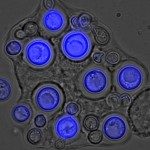Link to Pubmed [PMID] – 11204147
Med. Mycol. 2000;38 Suppl 1:205-13
The incidence of cryptococcosis rose dramatically with the advent of the acquired immune deficiency syndrome (AIDS) epidemic in the early 1980s until the early 1990s. The frequency of cryptococcosis has been declining since mid 1990s in Europe and America due to the development of more effective antiretroviral therapy and prophylactic treatment regimens designed to prevent fungal infections. The disease, however, is still recognized as one of the most common life-threatening opportunistic fungal infections in immunocompromised patients, particularly among those infected with human immunodeficiency virus (HIV). For this reason, research interest in clinical and biological aspects of the disease remains high. In addition to previously embarked areas of research, the cryptococcal research community has taken advantage of the current sequencing technology and initiated genome sequencing of Cryptococcus neoformans var. neoformans. This review includes various areas of research interest ranging from pathobiology, biochemistry and immunology, to genomics.

